|
|
|
Sort Order |
|
|
|
Items / Page
|
|
|
|
|
|
|
| Srl | Item |
| 1 |
ID:
158429
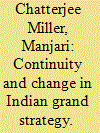

|
|
|
|
|
| Summary/Abstract |
This article offers an alternative understanding of India’s post-Cold War grand strategy by arguing that policy issues should be treated as a continuum within which there may be strategic policy innovations, leading to both nuanced continuity and change in foreign policy. Our argument stands in contradistinction to the dominant scholarship in the Indian foreign policy literature, the “transformation scholarship” as we term it, which views policy issues as binary, finds a “new” emphasis on material interests since the end of the Cold War and advocates this as both rational and commendable. Applying four key claims in the dominant transformation scholarship to two important Indian foreign policy issues, nuclear non-proliferation and climate change, we find that, rather than sweeping change in Indian grand strategy, as implied and advocated by transformation scholars, Indian grand strategy is in a state of flux, encapsulating some change but also much continuity.
|
|
|
|
|
|
|
|
|
|
|
|
|
|
|
|
| 2 |
ID:
158431
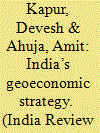

|
|
|
|
|
| Summary/Abstract |
Many observers recognize policy continuity as a prominent feature of India’s statecraft, but practitioners see fundamental changes in the last quarter century. In this article, we explain how India’s economic expansion because of sustained economic growth altered its statecraft. That prosperity is a prerequisite to sustain power has been well recognized through history by major thinkers of strategy. We examine the relationship between India’s economic strategy and its congruence with its foreign policy strategy. In particular, we illustrate how India has viewed geoeconomics, defined here as “the use of economic instruments to achieve specific geopolitical results.” We highlight the degree and instruments of India’s economic statecraft as an integral component of its foreign policy, and its strengths and limitations relative to other rising powers.
|
|
|
|
|
|
|
|
|
|
|
|
|
|
|
|
| 3 |
ID:
158435


|
|
|
|
|
| Summary/Abstract |
This article traces the evolution of India’s nuclear strategy over the past 20 years, as it went from reluctant nuclear power to a mature nuclear weapons nation. It explores the various doctrinal and postural choices India has made, and confronts, as its threat environment evolves and as its institutions have matured. Most notably, it analyzes various options to address the dilemma of Pakistan’s tactical nuclear weapons threat, and how India can adjust its nuclear posture and strategy to possibly escape the paralysis induced by that threat.
|
|
|
|
|
|
|
|
|
|
|
|
|
|
|
|
| 4 |
ID:
158430


|
|
|
|
|
| Summary/Abstract |
Political scientists and analysts have long argued that Indian strategic restraint is informed primarily by Indian political leaders’ aversion to the use of force. For some scholars, India’s apparent fixation with restraint can be traced to the very foundation of the modern Indian state. This article contests what it considers to be a reductionist position on strategic restraint. Instead, it argues that Indian strategic restraint has in fact been shaped more by structural issues such as the limited availability of logistics and capabilities, the impact of domestic political contest, the effect of international attention to a crisis and the need for international legitimacy, and the political, economic, and military cost-benefit analysis associated with the use of force and the potential for escalation. In sum, it contributes a historically grounded understanding of strategic restraint. The article looks closely at India’s decision-making process in one major experiment with the use of force against Pakistan in 1965. The case clearly shows that political leaders were hardly uncomfortable or unsure about the use of force. It was the military leadership at the time that sought to temper the ambitious and potentially escalatory policies considered by the then prime minister.
|
|
|
|
|
|
|
|
|
|
|
|
|
|
|
|
| 5 |
ID:
158427
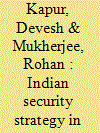

|
|
|
|
|
| Summary/Abstract |
As India assumes an increasingly salient role in world politics, questions of strategy have come to the fore in the study of Indian security. There is growing scholarly interest in Indian strategic thought and practice across a range of areas including conventional military power, nuclear weapons, maritime security, counterinsurgency, counterterrorism, and international regimes. This collection of articles expands the horizon of inquiry in some of these areas by situating Indian strategy in its historical context, by challenging conventional wisdom, and by opening new lines of research. In the following sections, we lay out the contours of what the contributors to this special issue collectively take to mean by strategy and then situate the issue in the literature on Indian strategy. We subsequently provide some over-arching observations on Indian strategy that emerge from the articles collected here and conclude by raising some questions regarding the intellectual and practical primacy of strategy in statecraft today.
|
|
|
|
|
|
|
|
|
|
|
|
|
|
|
|
| 6 |
ID:
158434
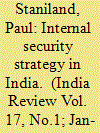

|
|
|
|
|
| Summary/Abstract |
The conventional wisdom among many analysts and policy-makers is that India’s central government has followed a fairly consistent internal security policy by deploying an “iron first in a velvet glove” that attacks irreconcilable armed groups, while holding open the door to mainstream politics for moderates. This article argues that this wisdom is incorrect. It instead offers a more political explanation of government strategy, showing that Delhi cares much more about some kinds of groups and conflicts than others, leading to a diverse pattern of strategies toward armed actors. Central government strategy is driven by varying political resolve for crackdowns and varying political space for either deal-making or neglect. Rather than a shared general approach, there is a far more selective and complex pattern of strategy. The paper examines both counterinsurgent conflicts and the murkier realm of private armies and armed political parties that blend “normal” politics with violence.
|
|
|
|
|
|
|
|
|
|
|
|
|
|
|
|
| 7 |
ID:
158433
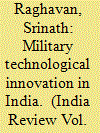

|
|
|
|
|
| Summary/Abstract |
This paper examines Indian strategy through the lens of military innovation. Comparing three major indigenous defense projects undertaken within a decade of each other, it asks why the Indian defense establishment managed to deliver on the Naval project while those of the Army and the Air Force were delayed by decades. To explain these differing outcomes, the paper argues, we need to analyze three inter-related issues: institutional capacity within the services; innovation strategy; and project management structures and accountability.
|
|
|
|
|
|
|
|
|
|
|
|
|
|
|
|
| 8 |
ID:
158432
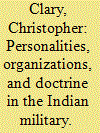

|
|
|
|
|
| Summary/Abstract |
The article explains when, why, and how Indian Army doctrine has changed since 1947. It traces Indian Army doctrinal evolution from defensive defense from 1947 to the mid-1960s, toward maneuver warfare after 1971, greater mechanization in the 1980s, and an emphasis on rapid, limited offensive strikes after 2002. It argues that in the absence of civilian intervention, the Indian Army has followed patterns predicted by organizational theory. The Indian Army has tended to avoid major doctrinal evolution and when doctrinal change has taken place it has consistently moved away from defensive orientations in favor of doctrines that maximize the initiative available to future Indian Army leaders to undertake offensive action. Doctrinal innovation has also been hampered by high turnover and apolitical selection of Indian Army chiefs, which inhibits continuity in efforts at doctrinal reform and modernization.
|
|
|
|
|
|
|
|
|
|
|
|
|
|
|
|
| 9 |
ID:
158428


|
|
|
|
|
| Summary/Abstract |
Although contemporary Indian strategic thought is described in terms of various schools, most scholars agree that prior to the end of the Cold War there prevailed a so-called Nehruvian consensus on India’s strategic objectives. This consensus was allegedly idealist, emphasizing autonomy, peaceful co-existence, and Third World anti-imperialist leadership. We argue that this characterization ignores numerous alternative views on Indian strategy that thrived in elite debates outside the uppermost echelons of power. Many of these views were grounded in pragmatism, or a flexible approach to considerations of power and material interest that eschewed dogmatic thinking, be it high moralism or offensive bluster. Through a case study of India’s response to China’s emerging nuclear program following the latter’s first nuclear test in 1964, we highlight the role that pragmatism played in the national debate and the way it shaped the strategic options considered by the elite at the time.
|
|
|
|
|
|
|
|
|
|
|
|
|
|
|
|
|
|
|
|
|